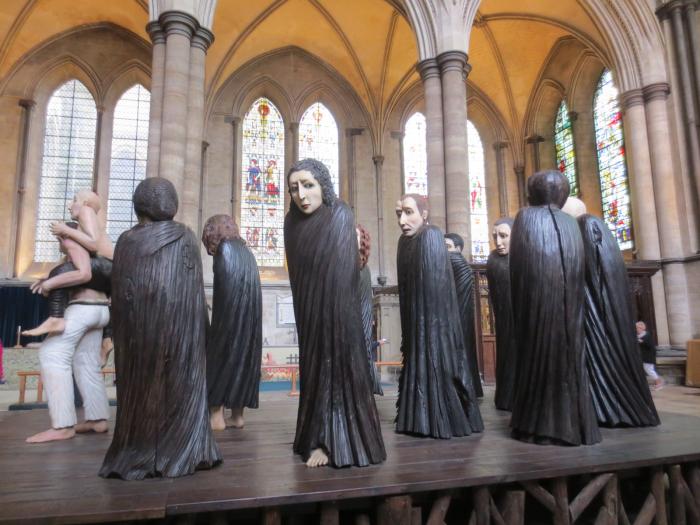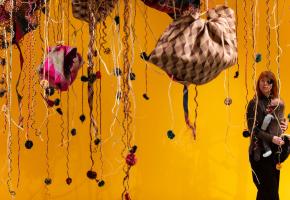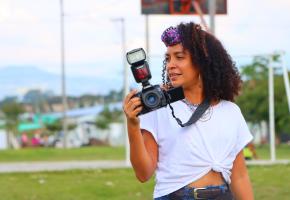As you walk through Salisbury cathedral, you encounter Ana Maria Pacheco’s powerful polychromatic sculptures, displayed as installations against the stunning backdrop of the vaulted medieval architecture. Curated by Jacquiline Creswell with Pratt Contemporary, the sculptures are arranged around the spaces as one main large group, plus many other studies, and a remarkable set of relief panels depicting the Seven Deadly Sins, aptly named “Be Aware”
Indeed!
Pacheco plays with scale, so the main group of 12 larger-than-life figures named “Shadows of the Wanderer” (pictured above) is set on a raised platform. This alters our viewpoint so that we are looking up at them. The individual figures are exquisitely hewn out of single piece of wood and polychromed. The use of acrylic for the teeth adds a powerful ingredient as the realistic enamel effect develops a life of its own, as do the onyx eyes, that reflect the ‘darkness of the soul within’.
These figures envelop the viewer with piercing stares, challenging us to respond. You cannot be in that space and not be emotionally affected. There is also the sheer technical brilliance of the carvings with their rich textures. Each figure is starkly individual, communicating an inner life, but also, there is a very specific power created by the sculptures as a group. They become the chorus of a Greek tragedy, the shadows, memories and pain that haunt and follow the lead figure of a young man carrying an older man on his back.
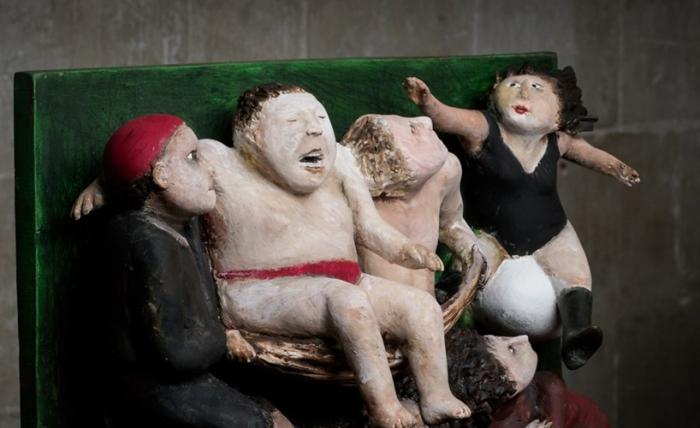
Ana Maria Pacheco says that she was inspired by Virgil's ancient poem The Aeneid, in which a Trojan Aeneas carries his lame father on his back, leading refugees from the burning ruins of Troy. This is particularly poignant as it is so topical today, evoking the suffering of those who are in the throes of exile, migration and displacements from their homes and countries right at this very moment.
You cannot witness this installation without feeling that pain as well. These shadowy figures appear to pace about their stage in agony. The curator, Jacquiline Crewell from Salisbury Cathedral, says she sees the theme as “…hope, an optimistic attitude, and a firm belief in the positive side of human nature”. Pacheco, on the other hand, says the figures are “… the shadows … [that] belong to the night; they are the memories that we carry within us in the depths of our mind”.
Pacheco’s work challenges us to reflect on our own humanity, her use of inventive creatures and monsters are the stuff of nightmares. It would be wrong, however, not to understand her deep connection to South America and its long tradition with magic realism. Some of these influences speak in these works and through her other work that has been exhibited in Norwich, Tate Britain, the National Gallery to name a few.
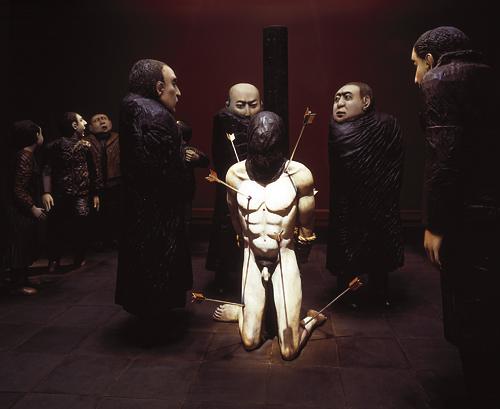 Dark Night of the Soul
Dark Night of the Soul
Ana Maria Pacheco was born in Brazil in 1943. After studying sculpture and music in Goiás and Rio de Janeiro, she lectured for a while before being awarded a British Council Scholarship to study at the Slade School of Art in 1973. She never looked back. Before long she became the first woman to be appointed Head of Fine Art at Norwich School of Art. In 1999, she received the prestigious ‘Ordem do Rio Branco’ from the Brazilian Government, an Honorary Degree from the University of East Anglia in 2003, and a fellowship from University College London.
While working as Associate Artist at the National Gallery, London (the first sculptor to hold the post), she produced a major exhibition of her work, Dark Night of the Soul 1999, that was her response to the ‘Martydom of St Sebastian’ by the Pollaiuolo Brothers.
The sheer volume of her creative output is astounding. She is also a prolific printmaker and a series of eleven etchings, ‘As proezas de Macunaíma’ have been purchased by Tate Britain for their permanent collection.
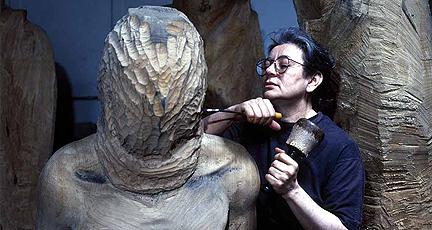
Her most recent series,’ Comedia’ 2016, was exhibited at the London Original Print Fair at the Royal Academy of Art. This series of coloured woodcuts is influenced by dances and songs of colonial Peru, in particular the ‘Son de los Diablos’. During this ‘carnival’ the people, mainly black dancers, dress as monsters, with horns and claws, grotesque masks, animal skins and feathers. There is a nightmarish transformation which bring with it a suggestion of a reversal of roles, as some character wield whips in defiance of colonial culture that was imposed upon them.
Ana Maria Pacheco lived in Brazil until 1973, so she experienced the harsh dictatorship that was imposed in 1964 after a Military coup replaced João ‘Jango’ Goulart. At times, these experiences can be felt in her work, either subtly or more viciously, as in ‘The Banquet’. Huge seated black figures, that are larger than those standing, form a circle around a defenceless figure prostrate on the table. The sharp (real) teeth that protrude from under their lips of the figures suggest that they will devour the victim. There is not only a suggestion of torture, but also cannibalism.
It is intensively disturbing. The idea of cannibalism representing ‘relationships’, was introduced as an idea in Brazil by the modernist poet and polemicist Oswald de Andrade in 1928, in his “Manifesto Antropófago” (Cannibalist Manifesto). In it, he suggested that Brazil would only overcome its dependence on European ‘colonial’ culture if it devoured it and regurgitated it as a stronger culture of its own. The iconic line of the manifesto is “Tupi or not Tupi: that is the question” referred to the practice of ritual cannibalism of enemy warriors among the indigenous Tupi tribes from central and coastal Brazil.
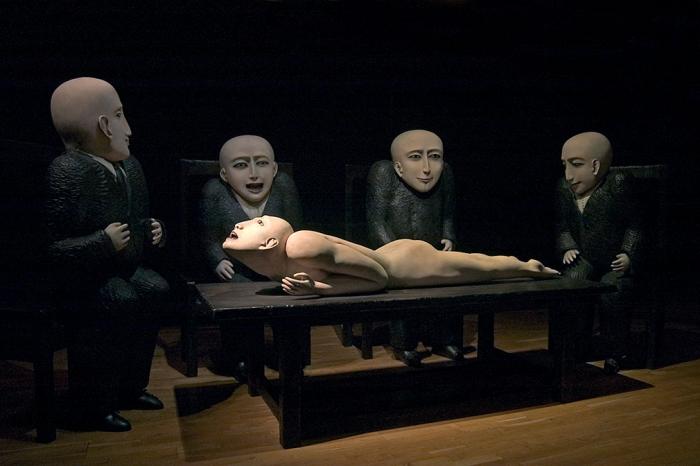 The Banguet Sculpture Group 2015 Norwich
The Banguet Sculpture Group 2015 Norwich
I made a pilgrimage, of sorts, to go down to Salisbury to see these works and it was worth every moment. The massive vaulted spaces of the cathedral added power. This is not just another art gallery, there is a definite spiritual and emotional dimension that comes across. Highly recommended!
Should you, very sadly, miss this excellent show, Ana Maria Pacheco is taking part in the Galway International Arts Festival in Ireland, from 17th – 30th July 2017. She will be exhibiting various works including the installation sculptures of “Dark Night of the soul”, first created when she had her residency as Associate Artist at the National Gallery.
Now that would be a serious pilgrimage and definitely worthwhile!
Ends July 23rd 2017.


